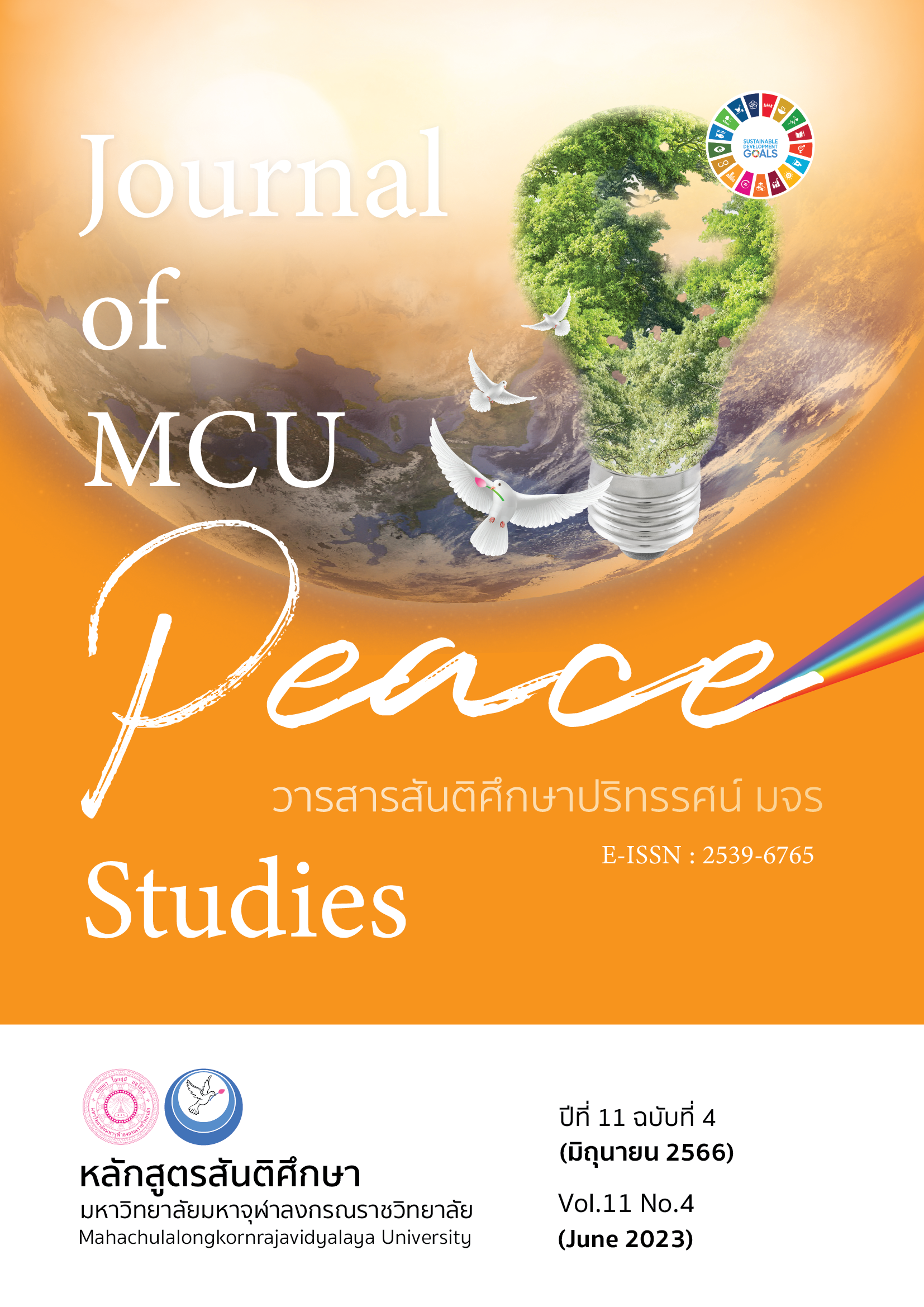แนวคิดการขุดสระเพื่อสร้างธนาคารน้ำอย่างยั่งยืนเชิงพุทธบูรณาการ
Main Article Content
บทคัดย่อ
บทความนี้ ผู้เขียนนำเสนอประเด็น แนวคิดการขุดสระเพื่อสร้างธนาคารน้ำอย่างยั่งยืนเชิงพุทธบูรณาการ ผู้เขียนได้ศึกษาแนวคิดการขุดสระปรากฏตามแนวคิดทางพระพุทธศาสนาการขุดสระและการขุดสระตามแนวคิดตามศาสตร์สมัยใหม่ วิเคราะห์อธิบายและบูรณาการแนวคิดการขุดสระเพื่อสร้างธนาคารน้ำอย่างยั่งยืนเชิงพุทธบูรณาการ สำหรับแนวคิดการขุดสระทางพระพุทธศาสนานั้นมีแนวคิดการขุดสระเป็นระยะๆ ทำบันไดทางขึ้นลง ทำราวมีหัวเสา มีลูกกรงและรั่วรอบสระ ขอบสระมีคัน ปลูกดอกบัวในสระ พื้นที่ขอบสระใช้ทำกิจกรรมแจกทาน ส่วนแนวคิดการขุดสระตามศาสตร์สมัยใหม่ตามแบบโคกหนองนาโมเดลเพื่อการจัดเก็บน้ำเป็นชลประทานเล็กๆ ดินที่ขุดสระนำไปทำโคกสำหรับปลูกป่า 3 อย่าง ประโยชน์ 4 อย่าง ขุดคลองไขน้ำ ทำฝายชะลอน้ำ ทำคันนาขนาดใหญ่เพื่อปลูกพืชผักต่างๆ ได้ สะสมน้ำไว้ใต้ดิน มี 2 ระบบ คือ ระบบเปิดกับระบบปิด เพื่อแก้ไขปัญหาน้ำหน้าแล้ง น้ำท่วม น้ำเค็ม น้ำสกปรก ช่วยทำให้ดิน ชุ่มชื่นและลดต้นทุนการจัดการน้ำในพื้นที่ ส่วนแนวคิดการขุดสระเพื่อสร้างธนาคารน้ำอย่างยั่งยืนเชิงพุทธ-บูรณาการ มีอยู่ 10 ประการ คือ 1) ขุดสระเพื่อจัดเก็บน้ำ 2) ทำบันไดขึ้นลงสระ 3) ทำราวมีหัวเสามีลูกกรงและรั่วรอบขอบสระ 4) ขอบสระทำคันกั้นดินขนาดใหญ่และใช้สำหรับการปลูกพืชผัก เรียกว่า คันดินทองคำ 5) ปลูกดอกบัวชนิดต่างๆ ในสระ 6) นำดินที่ขุดสระทำโคกสำหรับปลูกป่าโดยการเน้นปลูกป่า 3 อย่าง ประโยชน์ 4 อย่าง 7) ขุดคลองไขน้ำ เป็นลักษณะคลองใส้ไก่ รูปทรงคดเคี้ยวไปมา 8) ทำกั้นฝายเพื่อชะลอน้ำ และ 9) ขอบสระเป็นพื้นที่สำหรับแจกทานหรือทำกิจกรรมต่างๆ ได้ ดังกล่าวนั้น เป็นการขุดสระเพื่อสร้างธนาคารน้ำทำให้มีน้ำเพียงพอต่อการใช้สอยตลอดปีอย่างยั่งยืน
Article Details

อนุญาตภายใต้เงื่อนไข Creative Commons Attribution-NonCommercial-NoDerivatives 4.0 International License.
ทัศนะและความคิดเห็นที่ปรากฏในบทความในวารสาร ถือเป็นความรับผิดชอบของผู้เขียนบทความนั้น และไม่ถือเป็นทัศนะและความรับผิดชอบของกองบรรณาธิการ ยินยอมว่าบทความเป็นลิขสิทธิ์ของวารสาร
เอกสารอ้างอิง
Ampairin, Ch. (2018). Open Water Bank Know the Energy Value. Retrieved March 4, 2020, from https://www.youtube.com/watch?v=8R3jXhQ54r4
Boonpang, S. (2003). Groundwater Resources Management During Global Change at Sukhothai Groundwater Development Project, Sukhothai. (Master’s Thesis). Naresuan University. Phitsanulok.
Department of Groundwater Resources. (2021). 5 Benefits of Groundwater Replenishment. Retrieved June 1, 2023, from http://www.dgr. go.th/th/newsAll/124/5101
Homchuen, E. (2007). Efficiency of Cow Dung Powder to Reduce Water Turbidity in Newly Dug Pond. (Master’s Thesis). Khon Kean University. Khon Kean.
Kankritchakon, N. (2018). Open Water Bank Know the Energy Value. Retrieved March 4, 2020, from https://www.youtube.com/watch?v=8R3jXhQ54r4
Khunakup, P. (1998). Leaching of Saline Soils by the Construction of Mole Drain Combined with the Used od Soil Amendment Improving Soil Drainage. (Master’s Thesis). Kasetsart University. Bangkok.
Koadpratum, S. (2002). An Application of Geographic Information Systems in Land Evaluation for Public Excavated Ponds in Pa Kokpakgud and Papongdang Land Reformed Areas, Changwat Maha Sarakham. (Master’s Thesis). Khon Kean University. Khon Kean.
Kongton, B. et al. (2017). Knowledge Management and The Expansion of Water Management from the Village Degree to the Sub-District of Samrong Subdistrict, Pho Sai District, Ubon Ratchathan Province. (Research Report). Bangkok: Thailand Science Research and Innovation.
Kosonkittiumporn, S., Kenaphoom, S., Bunlouharnand, W., & Prachantasen, A. (2020). Water Resource Management: The Groundwater Bank Concept from Koakham Community, Ubon Ratchathani to Nongmamong, Chainat. Journal of MCU Ubon Review, 5(1), 395-408.
Mahachulalongkornrajavidyalaya University. (1996). Thai Tripitakas. Bangkok: MCU Press.
Onrit, P. (2018). Open Water Bank Know the Energy Value. Retrieved March 4, 2020, from https://www.youtube.com/watch?v=8R3jXhQ54r4
Ounlam, P. et al. (2019). Knowledge Management for Water Management for Community Strength and Self-Reliance on Sustainable Water Sources: A Case Study of Ban Kham Klang Groundwater Bank Project, Kao Kham Subdistrict, Nam Yuen District, Ubon Ratchathani Province. (Research Report). Bangkok: National Research Council of Thailand.
Phanthaphech, N., & Chittaladakorn, S. (2021). Sustainable Groundwater Bank Project Management Model of Yasothon Province. Journal of Social Science and Buddhistic Anthropology, 6(3), 92-106.
Phra Bhramagunabhorn (P. A. Payutto). (2008). Dictionary of Buddhism. (13th ed.). Bangkok: Saha Dhammika.
Phramaha Hansa Dhammahãso, Phrakrupalad Adisak Vajirapañño, Sakabuchaand, S., & Phophichit, N. (2022). A Model of the “Khok Nong Na” Buddhist Agriculture Development by Peace Studies Model for Sustainable Development: A Case Study of Sisaket Province. Journal of MCU Peace Studies, 10(1), 48-64.
Pinthong, J. (2018). Open Water Bank Know the Energy Value. Retrieved March 4, 2020, from https://www.youtube.com/watch?v=8R3jXhQ54r4
Rungsangmanoon, S. (2001). Heat Transfer Mechanism in Cooling Pond. (Master’s Thesis). Chulalongkorn University. Bangkok.
Sakolthus, N., & Phrakrupalad Adisak Vajirapañño. (2023). The Sustainable Development of Buddhist Agriculture by Buddhist Peace: A Case Study of Village No. 4, Nong Tae Village Community, Talin Chan Subdistrict, Mueang District, Suphan Buri Province. Journal of MCU Peace Studies, 11(2), 630- 645.
Salyakamthorn, W. (2016). New Theory Agriculture (1/8): The King’s Philosophy to Khok Nong Na Model. Retrieved March 7, 2020, from https://www.youtube.com/watch?v=-PCZwjK1Tio
Thaisiam, R., & Pornprommin, A. (2014). Experimental Study of Gully Formation by Overland Flow and Groundwater Flow. (Master’s Thesis). Kasetsart University. Bangkok.
Udomchok, Th., & Kwanyuen, B. (2003). Groundwater Management and Performance Evaluation of Sukhothai Groundwater Project. (Master’s Thesis). Kasetsart University. Bangkok.


